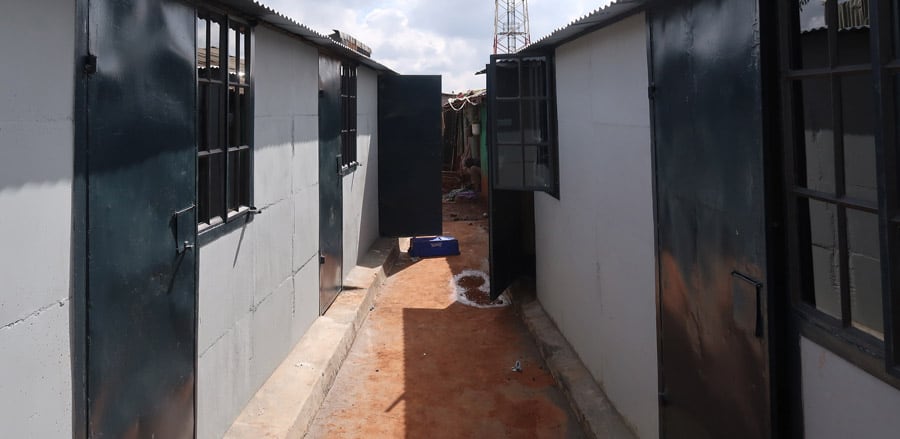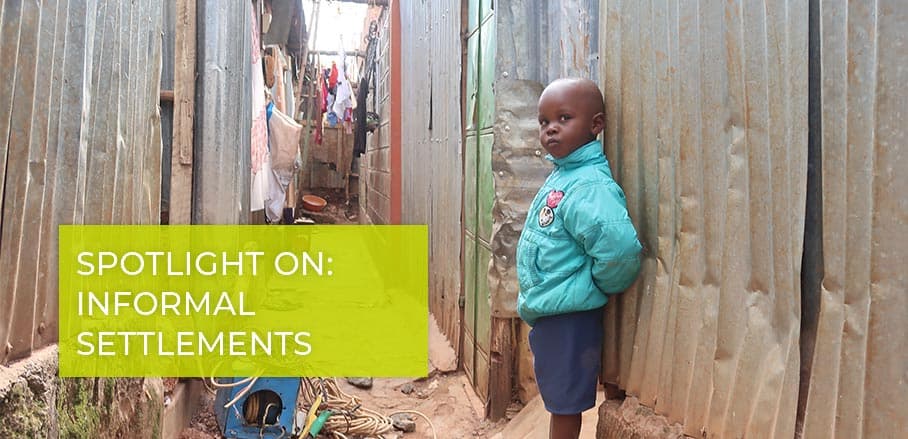A Spark of Hope: Making Nairobi’s Slums Fire Resilient
High density and poor building materials make informal settlements extremely prone to fire hazards. The Nairobi-based enterprise Kwangu Kwako has developed a housing model that, while being truly affordable, increases fire resilience and thus positively affects many aspects of residents’ lives.
A home is one of the basic human needs; it provides so much that is vital to nurture a family. The first words that people come up with when we ask them about a home are often “secure” and “safe”. Most of our homes do provide safety and security but, in informal settlements, where homes are made of metal sheets, mud, timber, et cetera, homes are often anything but safe, secure. Metal sheets are secured by nails that can just be pulled aside, possessions stolen when people are away or, much worse, when they are home. Mud homes are not much better.
Construction Contributing to Safety
Fire and the rapid spread of fire is a huge problem in informal settlements the world over. Arup, in a recent report, sum it up well:
“A fire in an informal settlement can affect thousands of people. Fires take lives, cause serious injuries, destroy property and have long-term impacts on livelihoods. Recovery is a long and difficult process, which can be exacerbated in informal settlements where financial instability, insecure tenure and a lack of insurance are common. But this global fire problem remains largely neglected.”
Families are ill prepared to cope with such financial, physical, and emotional traumas. A huge fire that took place in 2015 in Mukuru informal settlement in Nairobi is what inspired us to start Kwangu Kwako Limited (KKL): A social enterprise that manufactures and builds safer, truly affordable modular homes for low-income areas.
With a simple shift in thinking, we significantly improved the fire resistance and reduced the spread of fire – our original motivation. But, what was interesting in our journey at KKL was that, by doing that, we also improved security, made the homes cooler, healthier, et cetera.
There is more to improved homes than improved safety. Yes, we have to solve those problems, but the big advantage of improving safety and security is that it entails many wider, more qualitative impacts. As an indication – here are some statements by our customers:
“My first permanent home” Mercy, Kangemi.
“I can go to work safe in the knowledge that my things will still be there when I get home” Phoenix, Kawangware.
“My family would be so safe in one of these houses” Mike, Kibera.
“Finally I can have a conversation with my husband without the neighbours listening!” Anonymous, Kawangware.
For more on the impact of improved housing see the blog by Geoffrey Tann of the Massachusetts Institute of Technology.
Obstacles for Implementation
So, why aren’t there so much more people working on this? Well, there are people who are doing things differently, but they are often just concerned with few components of a house (interlocking blocks, solar, sanitation, et cetera), rarely with the whole house.
Plus, it is hard, it is slow. There are many obstacles, lots of administrative burdens. Investors often shy away, see the problems, lack the patience to realise the solutions, and so on. Those involved in construction are often quite conservative, there is a consistent drive to provide “normal” apartment style buildings and houses just like the middle income solutions – reference many failed and/or poor performing slum upgrading programmes that often take decades and/or get taken over by middle income families rather than by those they were intended to help.
Rethinking Requirements
These patterns can be broken: with a simple shift in materials and some lateral thinking, homes can be provided to those that need them the most, in the locations they need them, at the price they can afford.

© Kwangu Kwako Limited
But all too often, investors and donors ask for mutually exclusive requirements: floor areas far greater than are currently available to families, significant improvement in sanitation, lighting, et cetera, land security, fully compliant with building regulations, oh, and for the same price as the existing homes? While improvements in these areas are needed, the combination and extent of all of them is prohibitive without subsidy or grants. These requirements are what can cause the inertia and leave people, decades on, with little change to their homes.
Arup carried out a study “A Framework for Fire Safety in Informal Settlements” where, along with great guidance on how to deal with fires, they also proposed improvements to housing and the community that can prevent fires and the spread of fire:
- use of non-combustible materials (concrete, masonry, et cetera).
- establish and maintain fire breaks (non-combustible materials can help to provide this too).
- provide multiple escape routes from dwellings (challenging given layouts and security concerns).
- maximise separation distance to adjacent dwellings (again challenging given the typical density of an informal settlement).
What is great about these recommendations is that for most aspects, improvements in one area will complement another area of concern: reducing fire risk will generally improve security, make homes more resistant to heat gain, and much more.
The Wider Impact of Improved Housing
When people feel safe and secure in their homes, they will stay longer, invest more in the homes or, if renting, invest in longer term assets (for example in solar power, TVs). If they are safer and more secure, they are happier; if they stay longer, they will invest more in the community, become more involved, take more pride in the area.
“Communities that are resilient to fire can withstand, respond to and recover from severe fire incidents, thereby contributing to residents’ broader well-being and long term development.” – Arup
The value of an improved home goes far beyond the material cost or asset value. The direct and indirect gains are immeasurable yet significant. More research is needed in this area, and KKL are looking to work with others interested actors in this area to improve needed knowledge and understanding
- A Spark of Hope: Making Nairobi’s Slums Fire Resilient - 9. January 2020
